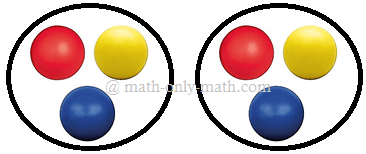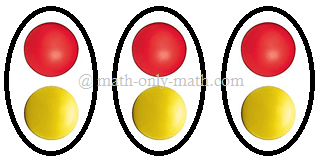Subscribe to our ▶️ YouTube channel 🔴 for the latest videos, updates, and tips.
Properties of Multiplication
In this section, we shall learn some interesting properties of multiplication.
1. Order Property of Multiplication:
Look at the figures given below:
|
3 + 3 = 6 Thus, 3 two times is 6. So, 2 × 3 = 6 |
2 + 2 + 2 = 6 Thus, 2 three times is 6. So, 3 × 2 = 6 |
What do we conclude?
We conclude that when two numbers are multiplied they may be taken in any order. The result remains the same. This is called the order property.
More examples: 4 × 3 = 3 × 4, 5 × 6 = 6 × 5 etc.
2. Multiplicative Property of 1:
Look at the figures given below:
|
1 + 1 + 1 = 3 Thus, 1 three times is 3 So, 1 * 3 = 3 Hence, 1 * 3 = 3 * 1 What do we conclude? |
Thus, 3 one is 3 So, 3 * 1 = 3 |
What do we conclude?
When a number is multiplied by 1, the answer is the number itself. This is called multiplicative property of 1.
More examples: 1 × 4 = 4, 1 × 8 = 8, 1 × 10 = 10 etc
3. Multiplicative Property of 0:
We know that: 0 + 0 + 0 + 0 = 0
Thus, 0 four times = 0
So, 0 * 4 = 0
By order property: 0 × 4 = 4 × 0
Hence, 0 × 4 = 4 × 0 = 0
Similarly, 0 + 0 + 0 + 0 + 0 = 0
Thus, 0 six times = 0
So, 0 × 6 = 0
But, 0 × 6 = 6 × 0
Hence, 0 × 6 = 6 × 0 = 0
What do we conclude?
We conclude that when any number is multiplied by zero, the product is always zero.
Basic Properties of Multiplication Video
Subscribe to our ▶️ YouTube channel 🔴 for the latest videos, updates, and tips.
Worksheet on Properties of Multiplication:
1. Fill in the empty boxes by using the properties of multiplication:
(i) 4 × 1 = _____
(ii) 9 × 0 = _____
(iii) 2 × 7 = _____ × 2
(iv) 5 × 0 = _____
(v) 10 × 1 = _____
(vi) 0 × 8 = _____
(vii) 3 × 5 = _____ × 3
(viii) 8 × 1 = _____
(ix) 0 × 7 = 7 × _____
(x) _____ × 13 = 13 × 6
(xi) _____ × 9 = 0
(xii) 6 × _____ = 3 × 6
Answer:
1. (i) 1
(ii) 0
(iii) 7
(iv) 0
(v) 10
(vi) 0
(vii) 5
(viii) 8
(ix)0
(x) 6
(xi) 0
(xii) 3
From 2-Digit Numbers Subtraction using Expanded Form to HOME PAGE
Didn't find what you were looking for? Or want to know more information about Math Only Math. Use this Google Search to find what you need.




New! Comments
Have your say about what you just read! Leave me a comment in the box below. Ask a Question or Answer a Question.